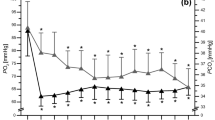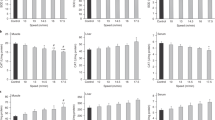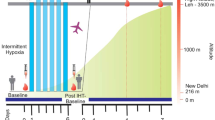Abstract
Background/Objectives:
We previously demonstrated that acute exposure to hypoxia (3 h at 3000 m) increased oxidative stress markers. Thus, by using the ‘living high–training low’ (LHTL) method, we further hypothesized that intermittent hypoxia associated with endurance training alters the prooxidant/antioxidant balance.
Subjects/Methods:
Twelve elite athletes from the Athletic French Federation were subjected to 18-day endurance training. They were divided into two groups: one group (control group) trained at 1200 m and lived in hypoxia (2500–3000 m simulated altitude) and the second group trained and lived at 1200 m. The subjects performed an acute hypoxic test (10 min at 4800 m) before and immediately after the training. Plasma levels of advanced oxidation protein products (AOPP), malondialdehydes (MDA), ferric-reducing antioxidant power (FRAP), lipid-soluble antioxidants normalized for triacylglycerols, and cholesterol and retinol were measured before and after the 4800 m tests.
Results:
After the training, MDA and AOPP concentrations were decreased in response to the 4800 m test only for the control group. Eighteen days of LHTL induced a significant decrease of all antioxidant markers (FRAP, P=0.01; α-tocopherol, P=0.04; β-carotene, P=0.01 and lycopene, P=0.02) for the runners. This imbalance between antioxidant and prooxidant might result from insufficient intakes in vitamins A and E.
Conclusions:
The LHTL model characterized by the association of aerobic exercises and intermittent resting hypoxia exposures decreased the antioxidant status whereas the normoxic endurance training induced preconditioning mechanisms in response to the 4800 m test.
This is a preview of subscription content, access via your institution
Access options
Subscribe to this journal
Receive 12 print issues and online access
$259.00 per year
only $21.58 per issue
Buy this article
- Purchase on Springer Link
- Instant access to full article PDF
Prices may be subject to local taxes which are calculated during checkout




Similar content being viewed by others
References
Askew EW (2002). Work at high altitude and oxidative stress: antioxidant nutrients. Toxicology 180, 107–119.
ASSFA (2003). Compléments et suppléments pour le sportif.In: Martin A (ed). Apports nutritionnels conseillés pour la population française, 3rd edn. Tec et Doc: Paris. pp 380–382.
Bailey DM, Davies B, Young IS, Hullin DA, Seddon PS (2001a). A potential role for free radical-mediated skeletal muscle soreness in the pathophysiology of acute mountain sickness. Aviat Space Environ Med 72, 513–521.
Brugniaux JV, Schmitt L, Robach P, Jeanvoine H, Zimmermann H, Nicolet G et al. (2006b). Living high–training low: tolerance and acclimatization in elite endurance athletes. Eur J Appl Physiol 96, 66–77.
Brugniaux JV, Schmitt L, Robach P, Nicolet G, Fouillot JP, Moutereau S et al. (2006a). Eighteen days of ‘living high, training low’ stimulate erythropoiesis and enhance aerobic performance in elite middle-distance runners. J Appl Physiol 100, 203–211.
Burke LM, Slater G, Broad EM, Haukka J, Modulon S, Hopkins WG (2003). Eating patterns and meal frequency of elite Australian athletes. Int J Sport Nutr Exerc Metab 13, 521–538.
Chao WH, Askew EW, Roberts DE, Wood SM, Perkins JB (1999). Oxidative stress in humans during work at moderate altitude. J Nutr 129, 2009–2012.
Chen CF, Tsai SY, Ma MC, Wu MS (2003). Hypoxic preconditioning enhances renal superoxide dismutase levels in rats. J Physiol 552, 561–569.
Clarkson PM, Thompson HS (2000). Antioxidants: what role do they play in physical activity and health? Am J Clin Nutr 72, 637–646.
Das DK, Maulik N (2006). Cardiac genomic response following preconditioning stimulus. Cardiovasc Res 70, 254–263.
Di Massimo C, Scarpelli P, Penco M, Tozzi-Ciancarelli MG (2004). Possible involvement of plasma antioxidant defences in training-associated decrease of platelet responsiveness in humans. Eur J Appl Physiol 91, 406–412.
Goldfarb AH, Bloomer RJ, McKenzie MJ (2005). Combined antioxidant treatment effects on blood oxidative stress after eccentric exercise. Med Sci Sports Exerc 37, 234–239.
Hercberg S, Galan P, Preziosi P, Bertrais S, Mennen L, Malvy D et al. (2004). The SU.VI.MAX Study: a randomized, placebo-controlled trial of the health effects of antioxidant vitamins and minerals. Arch Intern Med 164, 2335–2342.
Ji LL (1996). Exercise, oxidative stress, and antioxidants. Am J Sports Med 24, 20–24.
Joanny P, Steinberg J, Robach P, Richalet JP, Gortan C, Gardette B et al. (2001). Operation Everest III (Comex'97). The effect of simulated sever hypobaric hypoxia on lipid peroxidation and antioxidant defence systems in human blood at rest and after maximal exercise. Resuscitation 49, 307–314.
Kharb S, Singh V, Ghalaut PS, Sharma A, Singh GP (2001). Plasma lipid peroxidation and vitamin E levels in smokers. Indian J Med Sci 55, 309–312.
Kehrer JP, Lund LG (1994). Cellular reducing equivalents and oxidative stress. Free Radic Biol Med 17, 65–75.
Le Moulenc N, Deheeger M, Preziosi P, Monterio P, Valeix P, Rolland-Cachera MF et al. (1996). Validation du manuel photo utilisé dans l'enquête alimentaire SU.VI.MAX. Cah Nutr Diet 3, 158–164.
Levine BD (2002). Intermittent hypoxic training: fact and fancy. High Alt Med Biol 3, 177–193.
Levine BD, Stray-Gundersen J (1997). ‘Living high–training low’: effect of moderate-altitude acclimatization with low-altitude training on performance. J Appl Physiol 83, 102–112.
Levine BD, Stray-Gundersen J, Duhaime G, Schell PG, Friedman DB (1991). ‘Living high–training low’: the effect of altitude acclimatization/normoxic training in trained runners. Med Sci Sports Exerc 23, S25.
Marsh SA, Laursen PB, Coombes JS (2006). Effects of antioxidant supplementation and exercise training on erythrocyte antioxidant enzymes. Int J Vitam Nutr Res 76, 324–331.
Mezzano D, Pais EO, Aranda E, Panes O, Downey P, Ortiz M et al. (2001). Inflammation, not hyperhomocysteinemia, is related to oxidative stress and hemostatic and endothelial dysfunction in uremia. Kidney Int 60, 1844–1850.
Miyazaki H, Oh-ishi S, Ookawara T, Kizaki T, Toshinai K, Ha S et al. (2001). Strenuous endurance training in humans reduces oxidative stress following exhausting exercise. Eur J Appl Physiol 84, 1–6.
Morillas-Ruiz JM, Villegas Garcia JA, Lopez FJ, Vidal-Guevara ML, Zafrilla P (2006). Effects of polyphenolic antioxidants on exercise-induced oxidative stress. Clin Nutr 25, 444–453.
Ohno H, Yahata T, Sato Y, Yamamura K, Taniguchi N (1988). Physical training and fasting erythrocyte activities of free radical scavenging enzyme systems in sedentary men. Eur J Appl Physiol Occup Physiol 57, 173–176.
Palazzetti S, Richard MJ, Favier A, Margaritis I (2003). Overloaded training increases exercise-induced oxidative stress and damage. Can J Appl Physiol 28, 588–604.
Pialoux V, Mounier R, Ponsot E, Rock E, Mazur A, Dufour S et al. (2006). Effects of exercise and training in hypoxia on antioxidant/prooxidant balance. Eur J Clin Nutr 60, 1345–1354.
Robertson JD, Maughan RJ, Duthie GG, Morrice PC (1991). Increased blood antioxidant systems of runners in response to training load. Clin Sci (London) 80, 611–618.
Schroder H, Navarro E, Tramullas A, Mora J, Galiano D (2000). Nutrition antioxidant status and oxidative stress in professional basketball players: effects of a three compound antioxidative supplement. Int J Sports Med 21, 146–150.
Sen CK (1995). Oxidants and antioxidants in exercise. J Appl Physiol 79, 675–686.
Sen CK (2001). Antioxidants in exercise nutrition. Sports Med 31, 891–908.
Stray-Gundersen J, Chapman RF, Levine BD (2001). ‘Living high–training low’: altitude training improves sea level performance in male and female elite runners. J Appl Physiol 91, 1113–1120.
Subudhi AW, Jacobs KA, Hagobian TA, Fattor JA, Fulco CS, Muza SR et al. (2004). Antioxidant supplementation does not attenuate oxidative stress at high altitude. Aviat Space Environ Med 75, 881–888.
Urso ML, Clarkson PM (2003). Oxidative stress, exercise, and antioxidant supplementation. Toxicology 189, 41–54.
Vasankari TJ, Kujala UM, Rusko H, Sarna S, Ahotupa M (1997). The effect of endurance exercise at moderate altitude on serum lipid peroxidation and antioxidative functions in humans. Eur J Appl Physiol Occup Physiol 75, 396–399.
Vollaard NB, Shearman JP, Cooper CE (2005). Exercise-induced oxidative stress: myths, realities and physiological relevance. Sports Med 35, 1045–1062.
Wing SL, Askew EW, Luetkemeier MJ, Ryujin DT, Kamimori GH, Grissom CK (2003). Lack of effect of Rhodiola or oxygenated water supplementation on hypoxemia and oxidative stress. Wilderness Environ Med 14, 9–16.
Witko-Sarsat V, Friedlander M, Capeillère-Blandin C, Nguyen-Khoa T, Nguyen AT, Zingraff J et al. (1996). Advanced oxidation protein products as a novel marker of oxidative stress in uremia. Kidney Int 49, 1304–1313.
Acknowledgements
We thank the subjects for their contribution. We also thank Clark Ellice for reviewing the paper. This study was funded by the International Olympic Committee, the Ministère des sports français and the Direction Régionale de la Jeunesse et des Sports de la Région Auvergne.
Author information
Authors and Affiliations
Corresponding author
Rights and permissions
About this article
Cite this article
Pialoux, V., Mounier, R., Rock, E. et al. Effects of the ‘live high–train low’ method on prooxidant/antioxidant balance on elite athletes. Eur J Clin Nutr 63, 756–762 (2009). https://doi.org/10.1038/ejcn.2008.30
Received:
Revised:
Accepted:
Published:
Issue Date:
DOI: https://doi.org/10.1038/ejcn.2008.30
Keywords
This article is cited by
-
Nutrition and Altitude: Strategies to Enhance Adaptation, Improve Performance and Maintain Health: A Narrative Review
Sports Medicine (2019)
-
Blood Biomarker Profiling and Monitoring for High-Performance Physiology and Nutrition: Current Perspectives, Limitations and Recommendations
Sports Medicine (2019)
-
Alterations in Redox Homeostasis in the Elite Endurance Athlete
Sports Medicine (2015)
-
The effect of exercise-induced hypoxemia on blood redox status in well-trained rowers
European Journal of Applied Physiology (2012)
-
Living at high altitude in combination with sea-level sprint training increases hematological parameters but does not improve performance in rats
European Journal of Applied Physiology (2011)



